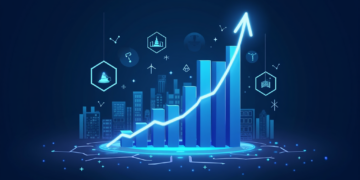Bluetooth satellite technology represents a groundbreaking advancement in space communication technology, enabling Bluetooth connectivity with satellites positioned high above the Earth. The Chinese startup Bluelink Satcom is at the forefront of this innovation, having recently secured early-stage funding to develop a satellite network capable of detecting Bluetooth signals from space. As the demand for satellite IoT solutions grows, Bluelink’s approach offers a cost-effective method to enhance connectivity in remote areas lacking proper infrastructure. With ambitious goals set for launching multiple payloads by 2028, this initiative could transform how Bluetooth-only devices communicate by leveraging satellites to facilitate data transmission over vast distances. As we explore the implications of this technology, it becomes evident that Bluelink Satcom is poised to revolutionize the landscape of satellite communication and IoT.
The emergence of Bluetooth satellite technology is reshaping the field of aerial communication, effectively merging terrestrial devices with orbital systems. Chinese firm Bluelink Satcom has carved a niche for itself by developing solutions that integrate satellite and Bluetooth connectivity, aiming to provide widespread Internet of Things (IoT) coverage. With its innovative focus on capturing Bluetooth signals from the atmosphere, the startup offers a promising glimpse into the future of remote monitoring and connectivity. The combination of space and Bluetooth not only addresses current limitations in conventional communication but also aligns with global efforts to expand satellite networks for improved data collection and transmission. As such, this initiative exemplifies how evolving space communication technology can bridge gaps in infrastructure and connectivity.
The Rise of Bluetooth Satellite Technology
Bluetooth satellite technology represents a transformative step in the realm of satellite IoT solutions. Traditionally, Bluetooth was limited to short-range communication between devices. However, the innovative approach that Bluelink Satcom is pioneering could change the landscape of wireless communication, enabling Bluetooth devices to connect and transmit data over vast distances through orbiting satellites. This capability can significantly enhance the scope and efficiency of Internet of Things (IoT) applications, particularly in remote or underdeveloped areas where traditional communication networks are sparse.
The implications of Bluetooth satellite technology extend beyond mere connectivity. By utilizing low-power Bluetooth signals, this technology can offer cost-effective solutions for various monitoring applications. For instance, it can be used to gather environmental data without the need for extensive infrastructure, thereby facilitating real-time data collection across large geographical areas. This shift not only reflects advancements in space communication technology but also underscores the potential for increased IoT coverage, particularly beneficial for sectors like agriculture, logistics, and urban infrastructure management.
Funding and Development Plans for Bluelink Satcom
Bluelink Satcom’s successful funding round underscores the growing interest and investment in satellite IoT innovations. With tens of millions of yuan raised, the startup is poised to take significant strides towards establishing China’s first Bluetooth satellite network. This funding will enable the company to cover crucial aspects of satellite construction and deployment, including operational activities and team expansion. Stakeholders like LinGe Ventures and Hongfu Capital recognize the potential impact of Bluelink’s technology on modern communication paradigms, marking a notable development in the evolving landscape of satellite and IoT solutions.
Looking ahead, Bluelink Satcom has ambitious plans to launch its first payload by mid-2024, with a goal of deploying a total of 72 satellites by the end of 2028. This strategic timeline indicates their commitment to rapid development and integration of Bluetooth connectivity into the satellite framework. The successful execution of this plan could position Bluelink as a frontrunner in the Chinese aerospace sector, particularly as the market for space communication technology continues to expand. Furthermore, their potential to leverage existing Bluetooth ecosystems may allow for faster adoption and scalability within the domestic sphere.
Applications of Bluetooth Satellite Networks
The introduction of Bluetooth satellites heralds numerous potential applications, particularly in fields requiring extensive data monitoring and collection. For instance, they can play a pivotal role in meteorological emergencies, providing timely data that can aid in disaster response and management. Traffic systems can also benefit, as real-time monitoring through Bluetooth-enabled devices can lead to improved traffic management and safety measures. The ability to replace manual oversight with automated systems enabled by satellite communication technology is truly revolutionary, promising increased efficiency.
Additionally, sectors such as infrastructure monitoring stand to gain significantly from Bluelink’s technology. The capacity to seamlessly track the condition of bridges, buildings, and roads through Bluetooth-only devices ensures that maintenance and safety assessments can be conducted with greater accuracy and less resource investment. The one-way communication model proposed by Bluelink allows these applications to operate without the need for heavy infrastructure, providing an elegant solution to many challenges faced in remote or poorly connected regions. This approach not only enhances the reliability of data but also opens doors for numerous IoT device applications.
Market Positioning of Bluelink Satcom
The competitive landscape of satellite IoT solutions is rapidly evolving, with Bluelink Satcom positioning itself strategically within this burgeoning market. While entities like Seattle’s Hubble Network aim for expansive global coverage through their satellite constellations, Bluelink competes by leveraging China’s robust domestic Bluetooth ecosystem. This localized advantage could enable the startup to scale its operations swiftly, tapping into existing consumer and industry familiarity with Bluetooth technology.
Moreover, Bluelink’s focus on adapting Bluetooth for satellite communications distinguishes it from other providers in the market. Current satellite IoT competitors often rely on proprietary technologies and hardware, which can limit their market reach and operational flexibility. By offering a Bluetooth-based solution, Bluelink not only simplifies connectivity for existing devices but also potentially reduces the financial barriers for widespread adoption of IoT technologies across various industries. This innovative approach signifies a notable shift in the satellite communications sector, aligning with the growing need for versatile and efficient connectivity solutions.
Technological Innovations Behind Bluetooth Satellites
At the core of Bluelink Satcom’s ambition lies its commitment to cutting-edge technological innovations aimed at revolutionizing satellite communication. The company is equipped with a highly sensitive payload designed specifically for the detection of weak Bluetooth signals from space. This sophisticated technology necessitates advanced engineering techniques to ensure reliable data transmission over vast distances, effectively overcoming some of the primary challenges in satellite communications.
The engineering feats required for a successful Bluetooth satellite deployment are substantial. Such innovations not only enhance signal detection capabilities but also demonstrate a deep understanding of atmospheric factors that can affect signal transmission. As Bluelink Satcom develops its system, it is likely to inspire further advancements in space communication technologies, paving the way for more diverse applications and use cases that leverage low-power satellite connectivity.
Impact of Government Support on Satellite Initiatives
Government support plays an essential role in the development of commercial space initiatives, particularly in emerging markets like China. The Chinese central government’s encouragement of the commercial space sector has catalyzed significant investments and the establishment of innovative companies like Bluelink Satcom. This backing provides startups with not only financial resources but also strategic frameworks within which they can operate and scale effectively in the competitive aerospace landscape.
As provinces and cities in China formulate action plans to nurture space companies, the environment for innovation and growth in satellite IoT solutions becomes increasingly favorable. By aligning with national objectives, Bluelink Satcom can leverage these initiatives to enhance their market presence and operational capabilities. The collaboration between public support and private ingenuity creates a roadmap for future breakthroughs in space technology that could have far-reaching implications for global communication systems.
Challenges Facing Bluetooth Satellite Development
Despite the significant promise of Bluetooth satellite technology, various challenges loom over its development. For example, navigating regulatory landscapes and securing necessary licenses for satellite launches can be cumbersome and may hinder timely deployment. Furthermore, the technical challenges inherent in ensuring reliable data collection from such a unique communication system cannot be underestimated. Addressing these hurdles will require robust strategic planning and technical expertise.
Additionally, there is the challenge of ensuring that the connectivity provided by Bluetooth satellites meets the growing demands of IoT applications. As industries increasingly rely on real-time data and communication, the effectiveness and efficiency of the existing Bluetooth technology must evolve. Bluelink Satcom’s commitment to continuous innovation and integration of new features will be crucial in overcoming these obstacles and capitalizing on the potential market opportunities that lie ahead.
Global Competitors in Satellite IoT
Bluelink Satcom operates in a competitive market characterized by other notable players, such as Hubble Network and Swarm. Hubble Network, with its plan for a vast constellation of 96 satellites, presents a formidable challenge by aiming to provide extensive global coverage. Meanwhile, Swarm has gained traction in the satellite IoT space through its distinct approach using proprietary hardware for connectivity, catering primarily to remote sensing and asset tracking.
However, Bluelink’s approach to Bluetooth satellite technology may serve as a differentiator. By tapping into the existing Bluetooth ecosystem, the company stands to engage a vast market of potentially compatible devices without necessitating new hardware. This could provide a unique positioning advantage, especially as traditional providers face challenges in scalability and infrastructure costs. Bluelink’s focus on low-power, low-data-rate solutions may become increasingly attractive as industries continue to explore efficient IoT implementations.
The Future of Satellite Communication Technology
The future of satellite communication technology is poised for profound changes, particularly with the advent of innovations such as Bluetooth satellite networks. As industries seek more resilient and cost-effective solutions, the potential for integrating low-power Bluetooth signals with satellite communication opens new avenues for growth and application. This evolution emphasizes the importance of adaptability within the aerospace sector, as companies like Bluelink Satcom strive to meet the demands for improved IoT connectivity.
In the broader context of space technology, the advancement of Bluetooth satellite systems could stimulate new research and exploration endeavors. By leveraging the unique properties of Bluetooth, Bluelink may inspire further innovations that enhance the scope of satellite capabilities, such as providing universal communication solutions to underserved regions globally. The convergence of Bluetooth and satellite technologies represents a promising frontier that highlights the ongoing evolution of space-based communication systems, ultimately shaping the future of IoT.
Frequently Asked Questions
What is Bluetooth satellite technology and how does it work?
Bluetooth satellite technology involves using satellites equipped to detect Bluetooth signals from devices on Earth. This technology, as pioneered by Chinese startup Bluelink Satcom, adapts traditional Bluetooth connectivity to operate across vast distances, allowing for one-way data transmission from devices like sensors directly to satellites orbiting the planet.
How can Bluetooth satellite technology benefit Internet of Things (IoT) solutions?
Bluetooth satellite technology enhances satellite IoT solutions by providing a cost-effective method for low-speed, wide-area connectivity. Bluelink Satcom’s approach utilizes low-power Bluetooth signals to improve communication for IoT devices in remote areas lacking traditional network infrastructure.
What applications are anticipated for Bluetooth satellite technology?
The initial applications for Bluetooth satellite technology include monitoring meteorological emergencies, traffic management, and structural integrity assessments for bridges and buildings. This technology enables efficient data collection and monitoring using Bluetooth-enabled devices, allowing for rapid responses to various situations.
Will devices need new hardware to use the Bluetooth satellite network?
No, devices will not require new hardware to utilize the Bluetooth satellite network. According to Bluelink Satcom, a simple software update via over-the-air firmware updates will enable existing Bluetooth-only devices to communicate with their satellites.
How many satellites does Bluelink Satcom plan to launch by 2028?
Bluelink Satcom aims to deploy a total of 72 satellites by the end of 2028. This ambitious plan is designed to ensure extensive coverage and fast revisit times for effective monitoring and data collection from Bluetooth devices.
Who are the main competitors of Bluelink Satcom in the Bluetooth satellite technology space?
Bluelink Satcom’s main competitor in the Bluetooth satellite technology space is the Seattle-based Hubble Network, which plans to launch a constellation of 96 satellites for global coverage by 2028. Bluelink leverages its connection to China’s Bluetooth ecosystem, which may provide a competitive edge.
What funding has Bluelink Satcom received to develop Bluetooth satellite solutions?
Bluelink Satcom has secured tens of millions of yuan in early-stage funding, approximately translating to $3 million to $13 million, to develop its Bluetooth satellite technology. This funding is intended for launching satellites and operational activities related to the initiative.
What is the significance of the technology developed by Bluelink Satcom?
The technology developed by Bluelink Satcom represents a significant innovation in space communication technology by utilizing Bluetooth connectivity to enable low-power and low-cost data transmission. This could profoundly impact how remote and underserved areas are connected, facilitating the proliferation of IoT devices.
| Key Point | Details |
|---|---|
| Funding Secured | Bluelink Satcom raised between $3 million to $13 million in early-stage funding for development of a Bluetooth satellite network. |
| Technology Overview | The startup aims to adapt Bluetooth technology for long-range communication via satellites designed to detect weak Bluetooth signals from considerable distances. |
| Application Areas | Initial use cases include meteorological emergencies, traffic management, and infrastructure monitoring. |
| Mission Scope | Plans to deploy a total of 72 satellites by 2028 to ensure effective coverage and data collection in remote areas. |
| Market Competition | Bluelink identifies Seattle-based Hubble Network as a competitor, which is developing a larger constellation of satellites. |
| Background Information | Founded in October 2023 by Cai Lingfeng, with experience in aerospace and space technology. |
Summary
Bluetooth satellite technology is set to revolutionize the way low-power devices communicate over long distances. The innovative work by Chinese startup Bluelink Satcom not only showcases the potential of using satellites to detect Bluetooth signals from space but also highlights the significant impact this can have on improving Internet of Things (IoT) connectivity in remote and underserved areas. With funding secured and ambitious plans to launch a constellation of satellites, Bluelink is poised to challenge existing market players and expand the capabilities of Bluetooth communication into new realms.












